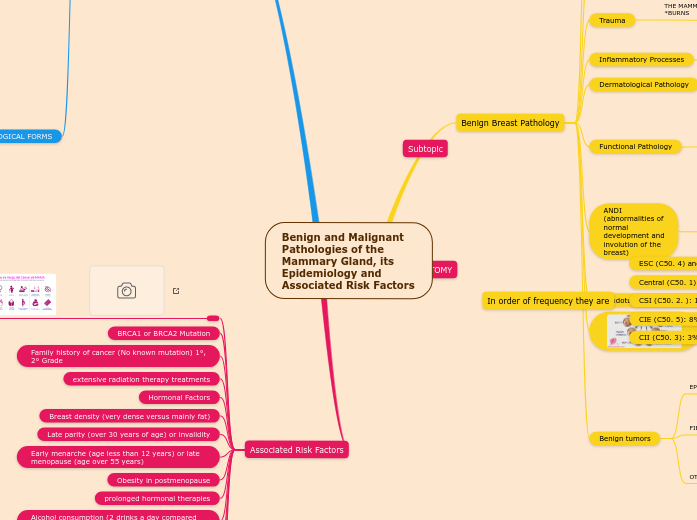PATOLOGICAL ANATOMY
In order of frequency they are
CII (C50. 3): 3%.
CIE (C50. 5): 8%.
CSI (C50. 2. ): 18%.
Central (C50. 1) or nipple (C50. 0): 25%.
ESC (C50. 4) and axillary portion (C50. 6): 49%.
Subtopic
Benign and Malignant Pathologies of the Mammary Gland, its Epidemiology and Associated Risk Factors
Associated Risk Factors
white race
Sedentary
Smoking before the first live birth
Alcohol consumption (2 drinks a day compared to non-drinkers)
prolonged hormonal therapies
Obesity in postmenopause
Early menarche (age less than 12 years) or late menopause (age over 55 years)
Late parity (over 30 years of age) or invalidity
Breast density (very dense versus mainly fat)
Hormonal Factors
extensive radiation therapy treatments
Family history of cancer (No known mutation) 1°, 2° Grade
BRCA1 or BRCA2 Mutation
Malignant pathology of the breast
HISTOPATOLOGICAL FORMS
Ductal carcinoma
• In situ (CDIS) 3. 3 and 5. 6%
• Infiltrator: 80%
Lobular carcinoma
• In situ ( intralobular carcinoma) 0. 8-1. 5%
• Infiltrator 3. 7-5. 8%
Medullary carcinoma
Mucinous carcinoma 1-2% (old women)
Tubular carcinoma
Papillary carcinoma 0. 3 and 1. 5%
Adenocystic carcinoma 1%.
Paget’s disease.
Inflammatory carcinoma 1-2% orange peel
SPEED OF GROWTH
Characteristics
Premenopausal
Undifferentiated tumor Pre- and post-menopausal
Tumor not undifferentiated
Postmenopause/Senile Tumor well differentiated
Tumor of 1 cm
2 years
8 years
18.5 years
Time doubling
23 daiys
90 days
209 days
PHASES OF TUMOR DISEASE
Stage of invasive carcinoma
Stage of carcinoma in situ
Hyperplasia-dysplasia phase
Induction phase
Benign Breast Pathology
Benign tumors
OTHER BENIGN BREAST TUMOR
*Myblastoma
*Leiomyoma
*Tumors of the nerves *Histiocytoma
*Vascular tumors
*Skin tumors benign
FIBROEPITHELIAL TUMORS
EPITHELIAL TUMORS
* Papillary nipple adenoma
* Breast adenoma
*Adenomyothelioma
* Intracanalicular apilloma
Pseudotumoral Processes Of The Breast
*ECTSIA DUCTAL
*GALACTOCELE
*HIPERPLASIA
EPITELIALS
ANDI
(abnormalities of
normal
development and
involution of the
breast)
*ADOLESCENT
BREAST
HYPERTROPHY
*FIBROADENOMA
*MASTALGIA AND
NODULARITY
*BREAST CYSTS
*ADENOSIS
SCLEROSANS
Functional Pathology
*TELORHEA
*LACTATIONAL
ABNORMALITIES
*GYNECOMASTIA
*PREMATURE
TELARCHE
Dermatological Pathology
DERMATITIS
Inflammatory Processes
*ACUTE MASTITIS
*CHRONIC NON-SPECIFIC
MASTITIS
Trauma
*INCISED WOUNDS
*CONTUSE WOUNDS
*STEATONECROSIS OF
THE MAMMARY GLAND
*BURNS
Malformations
CHANGES IN THE SITUATION
(a) Breast: Deviations may be:
+Uni or bilateral sides (“shield-shielded mates”). Towards up.
+Down.
(b) The nipple:
+Supraareolar nipple:
+Lateralized in the areola.
+Exoareolar nipple: Outside the areola (“supramarary nipple”).
ALTERATIONS OF THE FORM
(a) Breast: conical/pyriform, flattened/discoid, cylindrical, pediculate, pendulous.
(b) Nipple: Prominent, flattened, retracted/umbilicated, pediculated, bipartite.
(c) Of the areola: Prominent or withdrawn.
SIZE ALTERATIONS
-Mammary hypoplasia or micromasty
-Microtelia
- Breast hypertrophy or macromasty
-Macrotelia
ALTERATIONS IN THE NUMBER
Default
-Agenesia mammary
-Amastia
-Atelia
By excess
-Polyasty
-Ectopic Breast
-Momies aberrant
-Polyhelia

